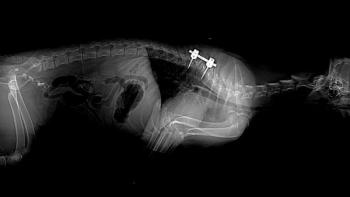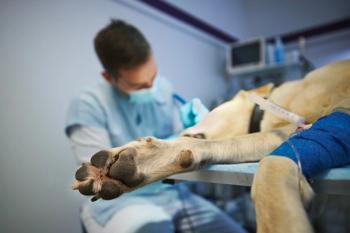
Primary epilepsy: what it is and isn't (Proceedings)
A seizure is the outward manifestation of a paroxysmal cerebral disorder resulting from a transitory disturbance of brain function.
Seizures and the relationship to epilepsy
a. A seizure is the outward manifestation of a paroxysmal cerebral disorder resulting from a transitory disturbance of brain function. It occurs suddenly and stops spontaneously.
b. The clinical appearance varies with location and severity of neuronal discharge. A seizure may result in a loss or derangement of consciousness, altered behavior or psychic changes (e.g. fly-biting, tail-chasing, etc.), abnormal muscle tone and/or movement, or autonomic disturbances such as urination, defecation, salivation, dilated pupils, vomiting, or diarrhea.
c. Because the external manifestation of seizures can vary considerably, any unusual involuntary phenomenon that is episodic and recurrent is a "potential" seizure disorder.
d. Areas of the brain that can result in seizures: Cerebrum, limbic system, and thalamus. Seizures can be a sign of anything from organic brain disease to genetically determined neuronal morphology/physiology that allows spontaneous depolarization.
e. The treatment and prognosis is dependent on the underlying cause of the seizure.
f. Estimates of seizure incidence are about 5.7% of all dogs and up to 1% of all cats.
Epilepsy
a. Term is derived from the Greeks and means, "to seize upon", "take hold of".
b. A single seizure can occur in an animal for a variety of causes, but if seizures recur over a period or time, the term epilepsy is applied.
c. In the strictest sense, the term epilepsy refers to recurrent seizure from any intracranial cause, from tumors to primary (idiopathic or inherited) epilepsy. However many people use the term only in reference to primary (idiopathic or inherited) epilepsy. Recurrent seizures from metabolic causes (e.g. hypoglycemia) are not epilepsy.
d. Epilepsy: Types that have been described
1. Idiopathic: Idiopathic epilepsy is a diagnosis by elimination, i.e. we look for other causes of seizures and if we can't find any, we call the epilepsy "idiopathic". Some reserve this term for dogs that have primary epilepsy; others use it less sparingly. It is very important to aggressively search for an underlying cause before resorting to this label for epilepsy. There can be 3 tiers or levels of diagnostics that can help one be more sure of the label:
a. Reviewing age of onset of seizure activity, breed, description of seizure activity, results of hemogram/chemistry profile/UA.
b. All of the above, plus thoracic radiographs, bile acids, and specific titers based on history and examinatio
c. All of 1 and 2 in addition to spinal fluid analysis and MRI or CT of the brain, CSF titers, EEG.
2. Inherited: This form of epilepsy is caused by a mutation in a specific gene that affected dogs inherited from their parents. Certain breeds are predisposed. A few breeds have proven hereditary epilepsy, while in most it is just a strong suspicion. Some prefer to use the "idiopathic" term instead of "inherited" or "hereditary" epilepsy unless there is more genetic evidence of inheritance; thus the reason for the overlap in descriptions.
3. Primary: In order to avoid using Inherited or Idiopathic Epilepsy when there is vs. Secondary/Symptomatic Epilepsy: Primary is reserved for idiopathic/inherited epilepsy meaning that there are no overt anatomical or histopathological lesions in the brain to explain the epilepsy. Secondary or Symptomatic Epilepsy implies that the seizures are due to an identifiable neurological disorder like brain trauma, cerebral neoplasia, active or inactive encephalitis, hypoxia.
4. Cryptogenic or "probably symptomatic" epilepsy is believed to be the result of a structural lesion of the brain that is not identified.
Pathophysiology of seizure activity
Genetics
The makeup of the internal workings of the neuron and its interactions with other neurons is determined by the genetics of the animal. A mutation in certain genes can cause neurons to be more excitable, reducing the seizure threshold. This is the very basic explanation of hereditary epilepsy. It is likely that there are many other influences and "triggers" for seizure activity since patients with hereditary epilepsy only seize intermittently and are "normal" clinically the rest of the time. We don't understand what regulates or affects the seizure threshold or why or when that seizure threshold will suddenly change to result in seizure activity.
Seizure threshold
The threshold of stimulation, which induces a seizure, is established by the environment of the neuron. If the threshold is exceeded, a seizure occurs. The seizure threshold likely varies amongst animals. Any animal may have a seizure if its "seizure threshold" is exceeded by too much excitation. Internal factors in a neuron regulate how excitable that cell is, but there can be external metabolic influences too. For example, seizures may be stimulated in some animals by fatigue, fever, light, estrus, etc.
Inhibition vs. excitation
Biochemical, neuronal hyperexcitability can be caused by either decreased inhibition or increased excitation from the synaptic input and neurotransmitters. Alterations in cell membrane and/or of cell metabolism also influence the neuronal discharge. Any alteration of the extracellular environment (structural or chemical) can lead to spontaneous discharge. Excessive and sudden electrical discharges of hyperexcitable neurons in the cerebral cortex, (likely subcortical neurons too) result in seizure activity. Hyperexcitable neurons can depolarize irregularly 700-1000 times a second and can increase in intensity to exceed the inhibition of adjacent neurons, inducing them to discharge. Thus the seizure discharge can spread to other areas of the brain: subcortical nuclei, thalamus, cerebrum, and brain stem.
Generalized vs. partial vs. partial with secondary generalization
Generalized
Diffuse, symmetrical, electrical discharge involving the entire cerebral cortex. Most often associated with toxicities, metabolic or nutritional deficiencies and primary epilepsy.
Partial
Simple partial seizure activity indicates an abnormal focus of electrical activity in one cerebral hemisphere. Complex partial seizures may affect both cerebral hemispheres. Spreading of the abnormal electrical activity involves structures of the limbic system; in some cases, the seizure activity becomes generalized (see below). Most partial seizures are associated with inflammatory, neoplastic, traumatic or metabolic insults (acquired seizures).
Partial with secondary generalization (PSG)
The partial seizure activity does not remain focal, but projects rapidly to subcortical structures to involve the entire brain. Signs are initially characterized by the function of the anatomical site of the seizure focus. The abnormal discharge spreads rapidly to become generalized seizures. PSG appear to be the most commonly observed seizure type in dogs (Heynold et al., 1997, Powell 1995, Berendt and Gram 1999, Berendt et al., 2001). In many patients, the partial seizure onset is very subtle and is followed by a rapid secondary generalization, which can make it difficult to detect the partial onset, (Holliday in 1980).
Primary/Inherited or genetic/true epilepsy
Incidence
The prevalence of epilepsy in the general dog population has been estimated at .5 to 5.7%. (Koestner, Cunningham). In some breeds, the incidence may be higher and some families may have up to 14% epileptics. A few reports suggest a higher incidence and an earlier age of onset of epilepsy in pups born to two epileptic parents.
Affected breeds
Epilepsy is believed to be inherited in 25 to 30 of breeds of dogs: Keeshond, Beagle, German Shepherd, Belgian Shepherd, Collie, Irish Setter, Boxer, Cocker Spaniel, Dachshund, Dalmatian, Saint Bernard, American Cocker, Malamute, Siberian Husky, Labrador retriever, Golden retriever, Belgian Tervuren, Irish Wolfhound, Pointer, Poodle (all varieties), Schnauzer (miniature & standard), Vizsla, Welsh Springer Spaniel, Wire Fox Terrier.
How is epilepsy inherited
A growing body of evidence supports a hereditary basis for idiopathic epilepsy, with a variety of genetic inheritance models ranging from simple autosomal recessive to polygenic recessive. Peer-reviewed scientific studies indicate a genetic basis for idiopathic epilepsy is available for Beagles (Bielfelt 1971), German Shepherds (Falco 1974), Keeshonds (Hall 1996), Dachshunds (Oliver 1994), Golden Retrievers (Srenk 1994), Labrador Retrievers (Leinweiner 1999), Bernese Mountain Dogs (Kathmann 1999), Vizslas (Patterson 2003), Belgian Tervurens (Oberbauer 2003), and English Springer Spaniels (Patterson 2005). These publications have indicated possible modes of inheritance, but the molecular bases are unknown at this time.
Elimination of epilepsy from gene pool
Since the most common mode of inheritance for epilepsy in dogs is either simple autosomal recessive or polygenic recessive, it will be very difficult to eliminate carriers from breeding until conclusive genetic tests are developed. Given emerging DNA technology for dogs, it is likely that genetic mutations will be identified in the next 3-5 years for some breeds. Given that different breeds (unless closely related) are likely to have different genes involved, it may be many more years until conclusive genetic tests are developed in for all the breeds.
Age of onset
Typically 6m-6yr. While generalized seizures used to be the primary description, it is becoming more apparent that many breeds have partial seizure activity that may then become generalized. The affected pet is normal in-between the seizures. Some pets appear to have seizures very regularly, while in others, the seizures appear to be precipitated by specific events such as stress, or changes in the weather. However for many epileptics, there is no pattern to their seizures.
Information about specific breeds
Miniature wirehaired dachshund
5 % in UK have Lafora's disease (in-breeding and gene mutation), a progressive myoclonic epilepsy accompanied by mental deterioration.
English Springer spaniels
JAVMA 2005 study of 45 epileptics and 74 siblings/parents: Median age at the onset of seizures was 3 years; however, 9 (20%) dogs were between 5 and 6 years old at the time of the onset of seizures. Twenty-one dogs (47%) had generalized seizures, and 24 (53%) had focal onset seizures. Results of segregation analysis were consistent with partially penetrant autosomal recessive or polygenic inheritance.
Vizslas
JVIM 2003 study of 29 epileptics, 74 unaffected siblings, and 41 parents suggested with autosomal recessive inheritance; however, polygenic inheritance could not be excluded as a possibility. 79% of affected Vizslas exhibiting partial onset seizures. Partial seizure signs included a combination of limb tremors, staring, pupillary dilatation, or salivation without loss of consciousness in > 50% of the dogs with partial signs.
Belgian Tervuren and sheepdog
J Hered 2003 study screened genomic DNA from families of affected Tervurens and sheepdogs and found it was highly heritable with a polygenic mode of inheritance, though apparently influenced by a single autosomal recessive locus. Based on figures from another study, it was estimated that the offspring of mating two dogs who have never had a seizure only had a 1% chance of seizing, while offspring with one parent who had seized had a 42% chance of suffering seizures.
Labrador retrievers
J Vet Intern Med 2002 study indicated that the prevalence of epilepsy in Denmark was 3.1 %, higher than the 1 % in the general canine population. In another study, Jaggy, Kathman and colleagues showed that having one epileptic parent increased the number of affected pups to 26% compared to 14% if neither parent seized in Labradors and 33% compared to 18% respectively in Bernese Mountain Dogs.
Irish Wolfhounds
J Vet Intern Med 2006 study analyzed clinical data and pedigrees from closely related Irish Wolfhounds (IW). Idiopathic epilepsy was diagnosed in 146 (18.3%) of 796 IW from 115 litters. The first seizure occurred by the age of 3 years in 73% of all dogs. Males were more commonly affected (61.6%) and had a older age of onset. Life span decreased by 2 years when compared with the average IW population. No simple mode of inheritance explained the pattern of affected dogs in pedigrees. Assuming all affected dogs had the same form of epilepsy, the simplest description of the complex pattern of inheritance observed was autosomal recessive with incomplete penetrance.
Newsletter
From exam room tips to practice management insights, get trusted veterinary news delivered straight to your inbox—subscribe to dvm360.




